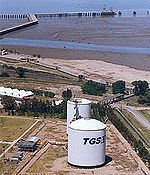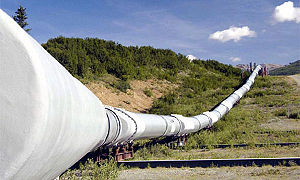
Transportadora de Gas del Sur
Encyclopedia
Transportadora de Gas del Sur (Gas Transporter of the South) is the largest natural gas
extractor in Argentina. The company was established in 1992, after the privatization of Gas del Estado, the state owned company that maintained the pipelines.
It is the most important gas supplier in Argentina, operating the biggest pipeline system of the country and of Latin America. Through its three main pipelines, the Neuba I, Neuba II and San Martín, the company transports 60% of the total Natural gas consumed in Argentina, and supplies distributors, electric generators and industries.
The maximum capacity is of 74.265.500 m3 a day, with an extension of 7.972 km of Pipeline transport
and a maximum potency of 579.09 HP.
TGS also distributes Liquefied natural gas
(LNG), Operating in the General Cerri complex in Buenos Aires Province
.
Telcosur S.A., another business company owned by TGS is dominating the telecommunications market in rural areas providing industries and facilities.
 Located in Buenos Aires Province the General Cerri Complex is dedicated to the recovery ethane, propane, butane, natural gasoline and NGL.
Located in Buenos Aires Province the General Cerri Complex is dedicated to the recovery ethane, propane, butane, natural gasoline and NGL.
All the products recovered are dispatched to Galván Harbor a near facility were are stored or loaded in trucks or ships for distribution.
The General Cerri Complex Produces 40% of the company income.
 TGS has three pipelines that produce 60% of the company income:
TGS has three pipelines that produce 60% of the company income:
The Neuba I runs from Sierra Barrosa to Bahía Blanca. Originally built in 1970, it was expanded in 1996. One of the main supplies of the company, the pipeline transports the gas supply from the basin in central Neuquén across Rio Negro, La Pampa and Buenos Aires provinces, ending in the General Cherri Complex. The gas is later transported to the Greater Buenos Aires
area.
The Neuba II, built in 1988, was expanded four times between 1996 and 2000. The pipeline begins in Cerros Colorados Complex
, in the Neueuqén basin. It crosses Neuquén, Río Negro, La Pampa and Buenos Aires, ending in Ezeiza, Buenos Aires. just outside of Buenos Aires. The pipeline is the main distribution for Buenos Aires
and Greater Buenos Aires as well.
The San Martin is the largest of the three, that provides with natural gas Tierra del Fuego Province
, Chubut province
, Rio Negro, Neuquén, and Buenos Aires provinces.
Natural gas
Natural gas is a naturally occurring gas mixture consisting primarily of methane, typically with 0–20% higher hydrocarbons . It is found associated with other hydrocarbon fuel, in coal beds, as methane clathrates, and is an important fuel source and a major feedstock for fertilizers.Most natural...
extractor in Argentina. The company was established in 1992, after the privatization of Gas del Estado, the state owned company that maintained the pipelines.
It is the most important gas supplier in Argentina, operating the biggest pipeline system of the country and of Latin America. Through its three main pipelines, the Neuba I, Neuba II and San Martín, the company transports 60% of the total Natural gas consumed in Argentina, and supplies distributors, electric generators and industries.
History
Transportadora de Gas del Sur was established on December 28, 1992 after the privatization of the Argentinian energy sector, it was part of Gas del Estado, a government regulated company divided later on Transportadora de Gas del Sur and Transportadora de Gas del Norte.Operations
Is the most important gas supplier in Argentina, operating the biggest pipeline system of the country and of Latin America transporting the 60% of the total Natural gas consumed and supplies directly to distributors, electric generators and industries.The maximum capacity is of 74.265.500 m3 a day, with an extension of 7.972 km of Pipeline transport
Pipeline transport
Pipeline transport is the transportation of goods through a pipe. Most commonly, liquids and gases are sent, but pneumatic tubes that transport solid capsules using compressed air are also used....
and a maximum potency of 579.09 HP.
TGS also distributes Liquefied natural gas
Liquefied natural gas
Liquefied natural gas or LNG is natural gas that has been converted temporarily to liquid form for ease of storage or transport....
(LNG), Operating in the General Cerri complex in Buenos Aires Province
Buenos Aires Province
The Province of Buenos Aires is the largest and most populous province of Argentina. It takes the name from the city of Buenos Aires, which used to be the provincial capital until it was federalized in 1880...
.
Telcosur S.A., another business company owned by TGS is dominating the telecommunications market in rural areas providing industries and facilities.
General Cerri Complex

All the products recovered are dispatched to Galván Harbor a near facility were are stored or loaded in trucks or ships for distribution.
The General Cerri Complex Produces 40% of the company income.
Pipelines

The Neuba I runs from Sierra Barrosa to Bahía Blanca. Originally built in 1970, it was expanded in 1996. One of the main supplies of the company, the pipeline transports the gas supply from the basin in central Neuquén across Rio Negro, La Pampa and Buenos Aires provinces, ending in the General Cherri Complex. The gas is later transported to the Greater Buenos Aires
Greater Buenos Aires
Greater Buenos Aires is the generic denomination to refer to the megalopolis comprising the autonomous city of Buenos Aires and the conurbation around it, over the province of Buenos Aires—namely the adjacent 24 partidos or municipalities—which nonetheless do not constitute a single administrative...
area.
The Neuba II, built in 1988, was expanded four times between 1996 and 2000. The pipeline begins in Cerros Colorados Complex
Cerros Colorados Complex
The Cerros Colorados Complex is a group of dams and hydroelectricity generation facilities on the lower valley of the Neuquén River, in Neuquén, Argentina.-Overview:...
, in the Neueuqén basin. It crosses Neuquén, Río Negro, La Pampa and Buenos Aires, ending in Ezeiza, Buenos Aires. just outside of Buenos Aires. The pipeline is the main distribution for Buenos Aires
Buenos Aires
Buenos Aires is the capital and largest city of Argentina, and the second-largest metropolitan area in South America, after São Paulo. It is located on the western shore of the estuary of the Río de la Plata, on the southeastern coast of the South American continent...
and Greater Buenos Aires as well.
The San Martin is the largest of the three, that provides with natural gas Tierra del Fuego Province
Tierra del Fuego Province (Argentina)
Tierra del Fuego is an Argentine province entirely separated from mainland Argentina by the Strait of Magellan. It includes:* The eastern part of the Isla Grande of Tierra del Fuego archipelago and the Staten Island.* Argentina's claims to the Falkland Islands and to...
, Chubut province
Chubut Province
Chubut a province in the southern part of Argentina situated between the 42nd parallel south and the 46th parallel south , the Andes range separating Argentina from Chile, and the Atlantic ocean...
, Rio Negro, Neuquén, and Buenos Aires provinces.
| Location | Details | ||||||||||||||||||||||||
|---|---|---|---|---|---|---|---|---|---|---|---|---|---|---|---|---|---|---|---|---|---|---|---|---|---|
|

